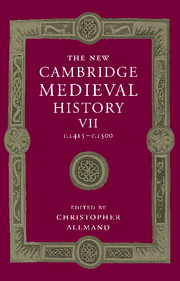
- Cited by 4
-
Cited byCrossref Citations
This Book has been cited by the following publications. This list is generated based on data provided by Crossref.
Fernández-Armesto, Felipe 2000. The Origins of the European Atlantic. Itinerario, Vol. 24, Issue. 1, p. 111.
Hankins, James 2010. Exclusivist Republicanism and the Non-Monarchical Republic. Political Theory, Vol. 38, Issue. 4, p. 452.
2012. Conseils et conseillers dans l’Europe de la Renaissance. p. 413.
Gil, Xavier 2019. The Iberian World. p. 7.
- Publisher:
- Cambridge University Press
- Online publication date:
- March 2008
- Print publication year:
- 1998
- Online ISBN:
- 9781139055758




